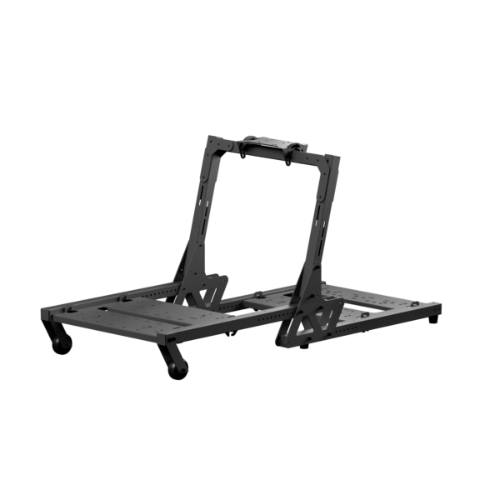Sim Racing Cockpits
Sim racing cockpits are the backbone of a proper racing setup. It provides a dedicated frame to mount your wheel, pedals, shifter, and seat. More than just a stand, it creates a stable, comfortable, and realistic driving environment.
Upgrading from a desk-and-chair setup makes a huge difference. A cockpit eliminates flex, locks in the correct driving position, and allows you to focus on racing instead of adjusting your gear mid-session. Whether you race casually or compete seriously, a cockpit can transform how you experience sim racing.
What Is a Sim Racing Cockpit?
A sim racing cockpit is a purpose-built frame that holds your sim racing gear in place. Unlike a desk setup, a cockpit positions everything in a way that mirrors a real car interior. It usually includes mounts for a wheel, pedals, and seat, with optional brackets for a shifter or handbrake.
The design eliminates wobble and sliding, even under strong force feedback. This stability makes your inputs more precise and your racing experience far more immersive.
Why Upgrade to a Cockpit?
A cockpit improves more than comfort. With a stable frame, your wheel and pedals stay fixed even under heavy load. This matters especially if you use stronger wheels or load cell pedals.
The correct driving posture also reduces strain in your back, shoulders, and legs. Long races become less tiring when your seating and gear alignment feel natural.
Finally, cockpits future-proof your setup. They can support stronger hardware as you upgrade, saving you from replacing unstable stands or makeshift solutions later.
Types of Sim Racing Cockpits
Not all sim racing cockpits are built the same. They range from compact stands designed for casual players to advanced aluminum rigs built for serious competitors. Understanding the main categories will help you decide which type best matches your space, budget, and long-term racing goals.
Wheel Stands
Wheel stands are the entry point for many racers. They’re portable, affordable, and take up little space. However, they lack rigidity and don’t provide a proper driving position. They suit casual players who want more stability than a desk but don’t need a full cockpit.
Entry-Level Cockpits
Entry-level cockpits combine a wheel stand with a seat mount. They’re compact and budget-friendly, making them ideal for beginners. Adjustment options are limited, but they offer a solid foundation for light to mid-range gear.
Mid-Range Cockpits
Mid-range rigs strike a balance between performance and value. They feature stronger frames, more adjustment options, and compatibility with a wider range of wheels and pedals. These cockpits are a smart choice for racers who want a stable setup that can grow with their gear.
High-End Cockpits
High-end cockpits are designed for serious sim racers. They often use aluminum profiles or reinforced steel tubing. These materials ensure maximum rigidity, even with high-torque direct drive wheels. Advanced rigs are fully modular, allowing for upgrades like motion platforms, triple monitor mounts, or tactile feedback systems.
Key Factors to Consider
When choosing a cockpit, keep the following factors in mind:
- Rigidity and Build Quality: A strong frame prevents flex and wobble under heavy use.
- Adjustability: The ability to fine-tune seat, pedal, and wheel positions ensures comfort.
- Compatibility: Confirm the rig fits your current hardware and supports future upgrades.
- Space and Portability: Some cockpits fold away, while others are permanent fixtures.
- Upgrade Path: Look for modular rigs if you plan to add motion, shifters, or handbrakes later.
Popular Brands
The sim racing cockpit market is filled with options, but a handful of brands have built strong reputations for quality, innovation, and value. Each has its own approach, whether that’s focusing on beginner-friendly rigs, offering a wide range across budgets, or delivering highly customizable solutions for advanced racers. By knowing the strengths of these leading brands, you can better match your cockpit choice to your own experience level, available space, and upgrade ambitions.
- Playseat: known for accessible and beginner-friendly rigs.
- Next Level Racing: offers a wide product range covering entry-level to advanced.
- GT Omega: balances affordability with sturdy design.
- Sim-Lab: respected for aluminum profile cockpits with high rigidity and modularity.
These brands provide a range of choices to match different budgets and racing ambitions.
Recommendations by Skill Level
As a beginner, start with a compact, affordable cockpit or even a solid wheel stand. This gives stability without taking up too much space.
As an intermediate, choose a mid-range cockpit with good adjustability. It should support mid-tier wheels and pedals while leaving room for upgrades.
As experienced, go for a high-end aluminum profile rig. These cockpits are modular, rigid, and ready for professional-level hardware and motion systems.
Key Takeaways
A sim racing cockpit adds stability, comfort, and realism to your setup by keeping your gear secure and your posture natural. Options range from simple wheel stands that suit casual racers to advanced aluminum profile rigs designed for professional-level hardware. The best choice depends on your budget, the gear you use today, and how much you plan to upgrade in the future.
